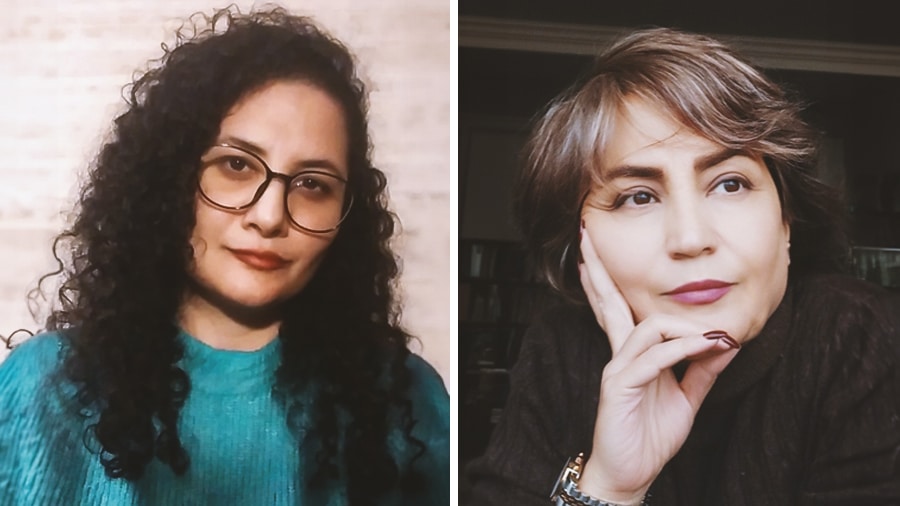Sima Hassandokht Firooz
The Emergence, Peak, and Decline of the Concept of “Underprivileged” in the Socio-Political Sphere of Contemporary Iran
Manijeh Mirmokri
Concepts and Gender Stereotypes in Central Kurdish and Persian
Moderator: Sepideh Siavashi
The panel titled “Concepts and Language: Social and Political Dynamics in Iran” features two key speakers who explore the roles of concepts and language in shaping Iran’s social and political landscape, with a focus on class and gender issues. The speakers delve into the evolution of important terms and how they reflect broader social movements and ideologies in the country.
Speaker 1: Sima Hassandokht Firooz
The Emergence, Peak, and Decline of the Concept of “Underprivileged” in the Socio-Political Sphere of Contemporary Iran
Sima Hassandokht Firouz’s presentation revolves around the emergence, peak, and eventual decline of the term “Mostaz’af” (the underprivileged) in Iran’s socio-political landscape. The term “Mostaz’af” gained prominence over roughly three decades before and after the 1979 Iranian Revolution, becoming a central figure in the discourse of both leftist and Islamist movements in the country.
Firouz examines how the term, which emerged in contrast to leftist terms like “working class” and “laborer,” evolved in response to the rise of political Islam in Iran. Firouz traces the concept’s roots to the pre-revolutionary period, highlighting how Islamist movements adopted “Mostaz’af” as a key symbol in their revolutionary narrative, despite internal contradictions in the term’s meaning.
During the revolution and shortly thereafter, “Mostaz’af” represented the Islamist vision of the oppressed masses, galvanizing people toward the revolutionary cause. However, even though the concept carried different connotations for various factions, it became a unified symbol under which Islamists could mobilize mass support.
With the Islamists’ rise to power and the subsequent establishment of the Islamic Republic, Firouz argues that the term “Mostaz’af” gradually faded from the political vocabulary of the ruling elite. While originally used to refer to oppressed individuals within Iran, the term’s meaning was expanded post-revolution to encompass oppressed nations or groups fighting imperialism globally. As time passed, “Mostaz’af” was replaced with more neutral and administrative terms like “vulnerable groups” or “underprivileged classes” to describe people in Iran.
This shift in terminology reflected a deeper change in governance and the state’s approach to addressing the needs of the population. Firouz concludes that the transformation of “Mostaz’af” shows how language and concepts are shaped by political power and changing ideologies, eventually losing their original radical meaning.
Speaker 2: Manijeh Mirmokri
Concepts and Gender Stereotypes in Central Kurdish and Persian
In the second presentation, Manijeh Mirmokri focuses on the presence of gender stereotypes in Persian and Middle Kurdish languages. Her presentation is grounded in the feminist critique of language, particularly the views expressed by second-wave feminists who believed that language reflects and reinforces gender inequality. According to Mirmokri, many languages, including Persian and Kurdish, contain linguistic elements that perpetuate male-dominated cultural narratives and marginalize women.
She discusses how certain philosophers of language from the mid-20th century argued that language shapes thought and reflects the worldview of its speakers. Social linguists and anthropologists support this idea, asserting that language and culture are so intertwined that it is often difficult to separate the two.
Mirmokri delves into feminist perspectives, particularly those of radical second-wave feminists, who argued that culture and language were tools used to reproduce gender inequality. These feminists called for linguistic reforms, such as the removal of certain sexist elements from language, in an effort to change societal attitudes and challenge patriarchal values.
The second half of the 20th century saw significant efforts to scrutinize language as part of the feminist struggle against patriarchy. Structuralist views, particularly those of Ferdinand de Saussure, had already posited that meaning in language is relational, defined by its position within a system of signs. This perspective had a profound impact on both linguistics and social sciences, leading to a reevaluation of how gender biases are embedded in language systems.
Mirmokri notes that feminist critiques of language spurred investigations into linguistic structures that reflect varying degrees of gender bias. Although this approach was later critiqued by post-structuralists for its essentialist stance, it remains a prominent method in studies of language and gender. Mirmokri’s research draws from linguistic examples collected from different texts in Persian and Middle Kurdish, aiming to identify and critique gendered elements at both the semantic and discursive levels.
Her findings suggest that both Persian and Middle Kurdish literature and discourse exhibit strong male-centered biases, perpetuating gender stereotypes. These languages not only reflect but also reinforce and solidify societal norms and expectations regarding gender roles. By analyzing how these stereotypes are encoded in language, Mirmokri highlights the need for a deeper understanding of how language can be both a reflection of and a tool for challenging existing power structures.
Conclusion
The panel addresses the dynamic interplay between concepts and language in shaping social and political realities in Iran. Firouz’s exploration of the concept of “Mostaz’af” demonstrates how political discourse evolves in response to shifts in power and governance.
Mirmokri’s investigation into gendered language reveals the deeper cultural underpinnings of inequality in Persian and Kurdish societies. Both speakers emphasize the importance of understanding how language not only reflects but also shapes the social and political landscape.



